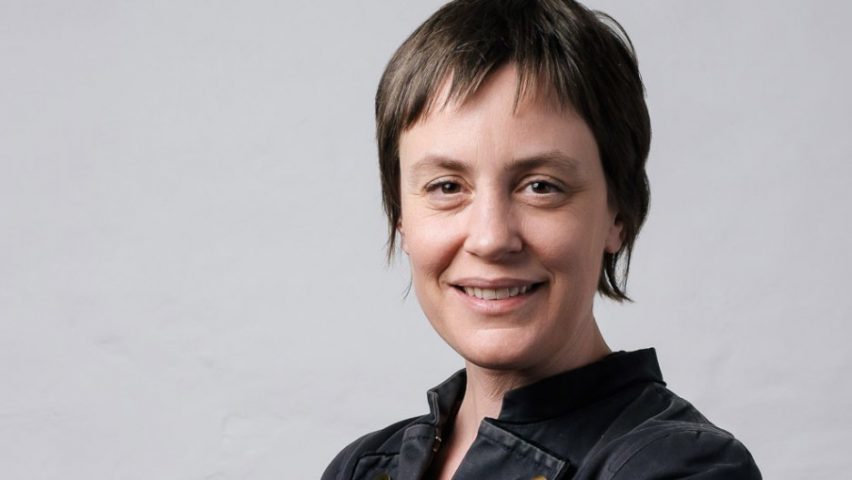Stirling Prize-winner Mikhail Riches will only work on zero-carbon projects from now on, the studio told Dezeen.
Co-founder Annalie Riches said the practice was committed to improving the environmental performance of its projects, after winning the UK's top architecture prize for the low-energy Goldsmith Street development.
"As a practice, we don't want to do anything that doesn't aim for zero carbon now," Riches told Dezeen.
Goldsmith Street achieves the rigorous Passivhaus standard for energy efficiency. Speaking at Mikhail Riches' north London studio, Riches said the studio now wanted to go further, and will aim to minimise the embodied carbon of all its upcoming projects.
"The next thing we need to think about is carbon in construction," said Riches. "It would be great to start to think about ways that we could improve on concrete and foundations, and find bricks that don't involve burning fossil fuels," she continued.
Embodied carbon refers to the total carbon dioxide generated by the construction of a building, including emissions created by extracting, processing and transporting building materials.
Her comments echoed those of partner David Mikhail, who said that reducing embodied carbon was the next step for sustainable architecture.
"I think we all know we have a climate and a species-loss emergency," he said when accepting the Stirling Prize in London last week. "So measuring embodied carbon has to be the next step."
Studio to follow Architects Declare principles
To achieve this, Riches said that the studio, which is based in Clerkenwell in London and employs 20 people, will try to meet the standards set by Architects Declare.
Architects Declare is an initiative launched in May by previous Stirling Prize winners. It calls on the architecture industry to shift behaviours to tackle climate change.
"We've signed up to Architects Declare – and we are very keen to ensure we stick to their 11 points going forward," she said.
The eleven principles vary from upgrading existing buildings as a more carbon-efficient alternative to demolition, carrying out whole-life carbon modelling and post-occupancy evaluation, and designing regenerative buildings that take carbon out of the atmosphere.
Michael Pawyln, a driving force behind the initiative, recently told Dezeen that architects need to think beyond creating buildings that have a neutral impact on the environment and instead aspire to producing regenerative architecture.
"We all fooled ourselves that sustainability was getting us where we needed to go and it was all making everything better," Pawlyn told Dezeen.
Mikhail Riches is exploring these issues in its ongoing regeneration of Sheffield's postwar Park Hill estate, and a housing development in York that it is designing with the same rigorous Passivhaus energy standard as Goldsmith Street.
"To bring that to life, we're working on phase two of the regeneration of Park Hill for Urban Splash," Riches explained. "We're saving as much of the original fabric as possible."
In York, the studio is working with City of York Council on a development of 600 homes.
"York are also aiming for 100 per cent certified Passivhaus," Riches said. "We're also working with them to find ways of achieving zero carbon in construction."
Architects must now "push clients and the government"
However, Riches stated that environmentally-conscious architecture and housing like Goldsmith Street will only become commonplace in the UK if there is more demanding legislation on designing and building in a climate emergency.
She believes architects – as demonstrated by the number of Architects Declare signatories – are ready and willing to do this, but that they have limited power. To encourage clients to be more ambitious, authorities must lead the way.
"Architects are really up for it, so we need to push the clients and the government. We have limited influence over these things," she said.
She continued: "We need legislation. It's very disappointing that the only real performance target left is Passivhaus because other things have been dropped. It's incredibly disappointing."
She pointed out that there is "no universally accepted definition of zero carbon and no industry wide protocol," adding: "But we're still looking into this. It's a work in progress."
Council-led housing threatened by interest rate rise
Riches also highlighted the recent announcement that finance from the Public Works Loan Board, through which the government lends money to local authorities, would now charge higher interest rates.
She worries that the one-per-cent increase in interest rates, which is expected to cost councils an extra £70 million a year, will hinder the incorporation of eco-friendly designs in council-led housing schemes.
"What's good is hearing that councils are actually declaring a climate emergency," Riches said. "But then the next day you get the increase in interest on council borrowing. That probably gets rid of the eco stuff, doesn't it?"
But Riches hopes that Goldsmith Street's Stirling Prize win will motivate other councils to follow suit.
"Let's be positive," she said, pointing out that many clients want to create more sustainable architecture. "What's great about this project winning the prize is it does demonstrate to local authorities that it is possible."
Portrait is by Mark Hadden.

